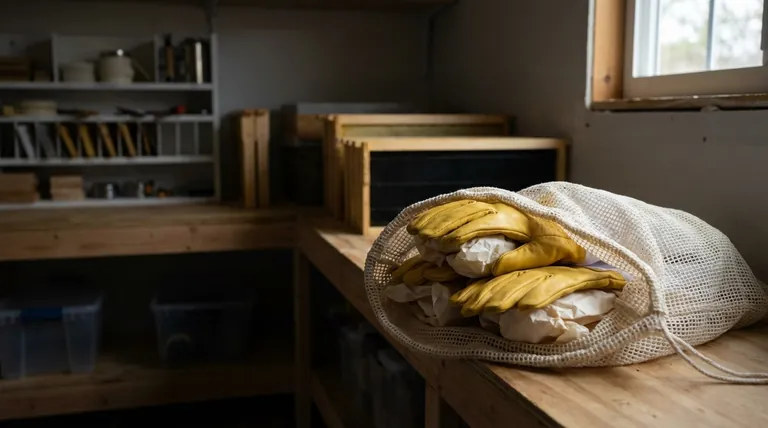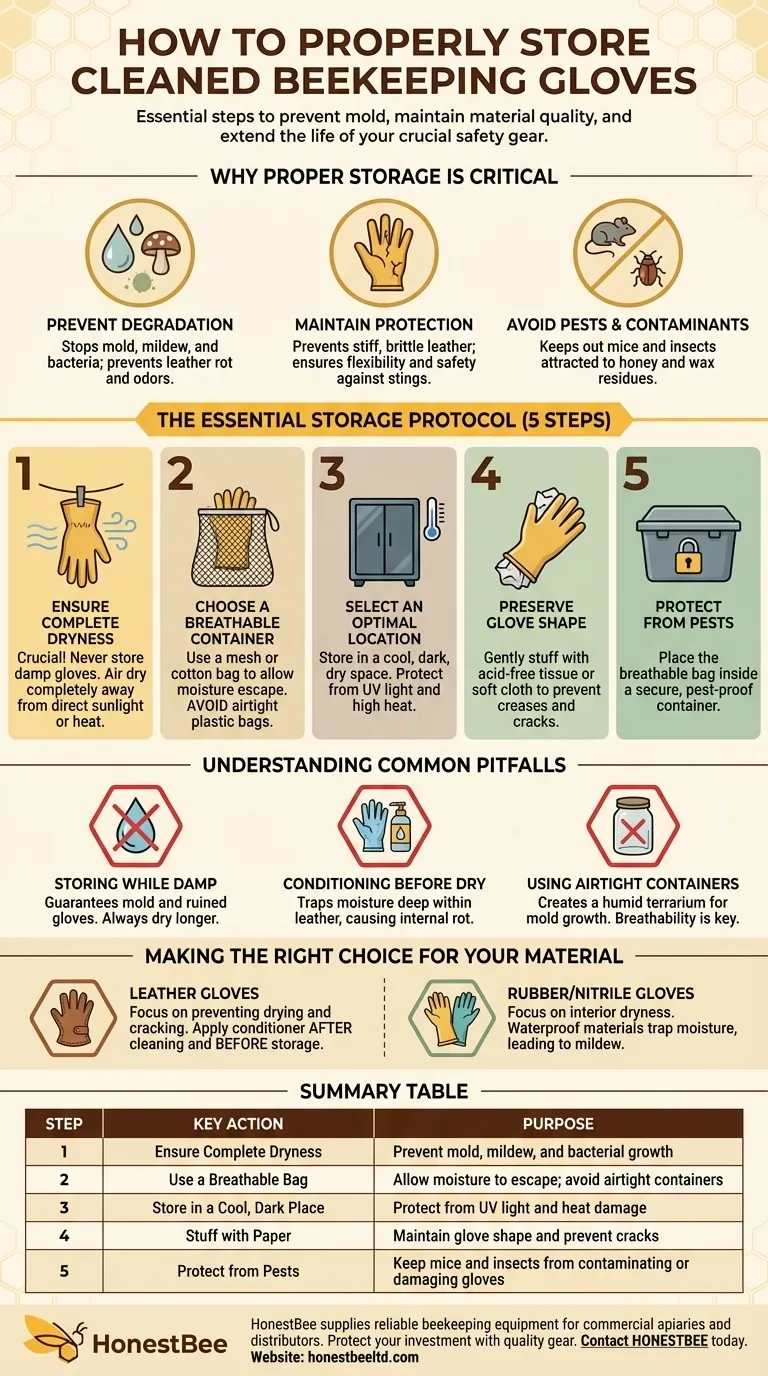To properly store cleaned beekeeping gloves, you must first ensure they are completely dry to prevent mold and mildew. Store them in a breathable bag in a cool, dark location, stuffed with paper to maintain their shape, and in a place where they are protected from pests like mice. This simple protocol preserves the material and extends the usable life of your gloves.
Your gloves are a primary line of defense against stings. Storing them correctly is not just about equipment maintenance; it's a critical step in ensuring your safety and confidence during hive inspections.

Why Proper Storage is Critical
The goal of storing your gloves is to protect them from their primary enemies: moisture, light, heat, and physical damage. Proper storage directly impacts their longevity and protective capabilities.
Preventing Material Degradation
Moisture is the single greatest threat during storage. Even a small amount of trapped water can lead to mold, mildew, and bacterial growth, which will degrade leather and create foul odors in any material.
Maintaining Protective Qualities
Leather that is stored improperly can become stiff and brittle. Cracked, inflexible gloves offer less protection and severely limit the dexterity needed for delicate hive work.
Avoiding Pests and Contaminants
Residue from honey, wax, and propolis can attract pests like mice and insects. Proper cleaning and sealed storage in a pest-proof area are essential to prevent your gloves from being chewed or contaminated.
The Essential Storage Protocol
Follow these steps after every cleaning to ensure your gloves are ready for your next inspection.
Step 1: Ensure Complete Dryness
This is the most important step. Never store damp gloves. After washing, hang your gloves to air dry completely, away from direct sunlight or artificial heat, which can damage leather and synthetics.
Step 2: Choose the Right Container
Use a breathable storage bag, such as one made from mesh or cotton. This allows any trace amounts of moisture to escape. Avoid sealed plastic bags, which trap moisture and create a perfect environment for mildew.
Step 3: Select an Optimal Location
Store your gloves in a cool, dark, and dry space like a closet or a workshop cabinet. UV light from the sun degrades and weakens leather, while high heat can cause it to become brittle and shrink.
Step 4: Preserve Glove Shape
Gently stuff your gloves with acid-free tissue paper or a soft cloth. This helps them retain their natural shape, preventing deep creases that can eventually turn into cracks.
Step 5: Protect from Pests
Place your breathable bag of gloves inside a larger, secure container such as a sealed storage bin or a sturdy cabinet. This provides a physical barrier against mice and other pests.
Understanding the Common Pitfalls
Avoiding a few common mistakes is just as important as following the correct procedure. These errors can quickly undo the effort of careful cleaning.
Mistake #1: Storing While Damp
This is the most frequent and damaging error. It guarantees mold and mildew, ruining leather and making synthetic gloves unusable due to odor and bacteria. Always err on the side of letting them dry longer.
Mistake #2: Conditioning Before Fully Dry
If you use leather gloves, you must apply a conditioner to keep them supple. However, applying it before the leather is completely dry can trap moisture deep within the material, leading to rot from the inside out.
Mistake #3: Using Airtight Containers
Sealing gloves in a plastic bag or an airtight bin seems like a good way to protect them. However, if they are not perfectly, bone-dry, you are creating a terrarium for mold growth. Breathability is key.
Making the Right Choice for Your Material
Your storage strategy should align with the material of your gloves.
- If you use leather gloves: Your primary focus is on preventing the leather from drying out and cracking, so conditioning after cleaning and before storage is essential.
- If you use rubber or nitrile gloves: Your primary focus is ensuring the interior is completely dry, as these waterproof materials trap moisture and can easily develop mildew inside.
- If your primary focus is longevity: Implement the full protocol by ensuring complete dryness, using a breathable bag, storing in a cool, dark place, and protecting against pests.
Properly stored equipment is reliable equipment, giving you the peace of mind to focus on your bees.
Summary Table:
| Step | Key Action | Purpose |
|---|---|---|
| 1 | Ensure Complete Dryness | Prevent mold, mildew, and bacterial growth |
| 2 | Use a Breathable Bag | Allow moisture to escape; avoid airtight containers |
| 3 | Store in a Cool, Dark Place | Protect from UV light and heat damage |
| 4 | Stuff with Paper | Maintain glove shape and prevent cracks |
| 5 | Protect from Pests | Keep mice and insects from contaminating or damaging gloves |
Protect your investment and your safety with the right equipment. Properly storing your beekeeping gloves is crucial for longevity, but it starts with having high-quality, durable gloves. HONESTBEE supplies commercial apiaries and beekeeping equipment distributors with reliable, wholesale-focused beekeeping supplies and equipment designed to withstand rigorous use. Ensure your gear is always ready for hive inspections. Contact HONESTBEE today to explore our wholesale catalog and equip your operation for success.
Visual Guide

Related Products
- Beekeeping Gloves Goatskin Leather with Long Cotton Sleeve for Beekeepers
- Goatskin Leather Beekeeper Gloves with Vent Long Sleeve for Beekeeping Honey Bee Sting Proof Protection
- Mesh Ventilated 3 Layer Goatskin Beekeepers Gloves for Beekeeping
- Goat Skin Leather Bee Sting Proof Beekeeping Gloves with Canvas Sleeve
- Professional Galvanized Hive Strap with Secure Locking Buckle for Beekeeping
People Also Ask
- What is the difference between cleaning cow leather and goat leather beekeeping gloves? Tailor Your Care for Longevity
- Why do some experienced beekeepers choose not to wear gloves? For Superior Dexterity & Hive Welfare
- What is the safest way to handle frames in beekeeping? Master Gentle Handling for a Calm Hive
- Why is dexterity and flexibility important in beekeeping gloves? Boost Your Hive Management Efficiency
- What are the arguments for and against using gloves in beekeeping? Balancing Protection and Dexterity



















